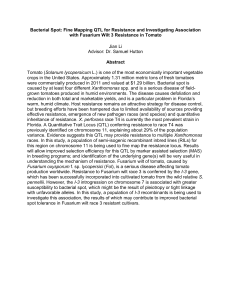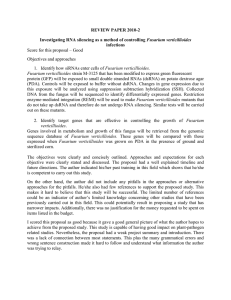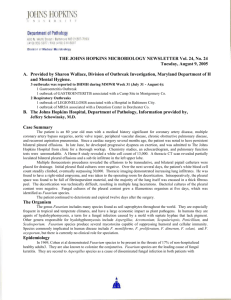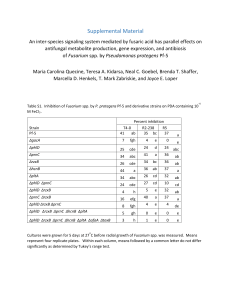Use of an Insulin Syringe for Fusarium Wilt Inoculation of... Germplasm
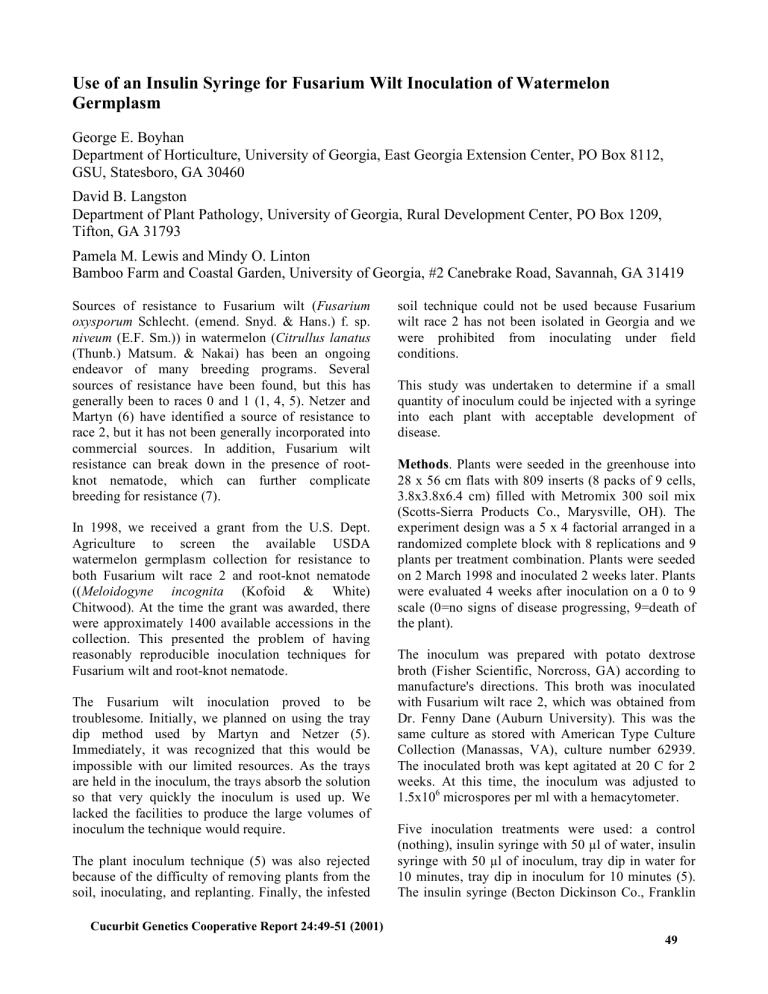
Use of an Insulin Syringe for Fusarium Wilt Inoculation of Watermelon
Germplasm
George E. Boyhan
Department of Horticulture, University of Georgia, East Georgia Extension Center, PO Box 8112,
GSU, Statesboro, GA 30460
David B. Langston
Department of Plant Pathology, University of Georgia, Rural Development Center, PO Box 1209,
Tifton, GA 31793
Pamela M. Lewis and Mindy O. Linton
Bamboo Farm and Coastal Garden, University of Georgia, #2 Canebrake Road, Savannah, GA 31419
Sources of resistance to Fusarium wilt ( Fusarium oxysporum Schlecht. (emend. Snyd. & Hans.) f. sp. soil technique could not be used because Fusarium wilt race 2 has not been isolated in Georgia and we niveum (E.F. Sm.)) in watermelon ( Citrullus lanatus
(Thunb.) Matsum. & Nakai) has been an ongoing endeavor of many breeding programs. Several sources of resistance have been found, but this has generally been to races 0 and 1 (1, 4, 5). Netzer and
Martyn (6) have identified a source of resistance to race 2, but it has not been generally incorporated into commercial sources. In addition, Fusarium wilt resistance can break down in the presence of rootknot nematode, which can further complicate breeding for resistance (7).
In 1998, we received a grant from the U.S. Dept.
Agriculture to screen the available USDA watermelon germplasm collection for resistance to both Fusarium wilt race 2 and root-knot nematode
(( Meloidogyne incognita (Kofoid & White)
Chitwood). At the time the grant was awarded, there were approximately 1400 available accessions in the collection. This presented the problem of having reasonably reproducible inoculation techniques for
Fusarium wilt and root-knot nematode.
The Fusarium wilt inoculation proved to be troublesome. Initially, we planned on using the tray dip method used by Martyn and Netzer (5).
Immediately, it was recognized that this would be impossible with our limited resources. As the trays are held in the inoculum, the trays absorb the solution so that very quickly the inoculum is used up. We lacked the facilities to produce the large volumes of inoculum the technique would require.
The plant inoculum technique (5) was also rejected because of the difficulty of removing plants from the soil, inoculating, and replanting. Finally, the infested were prohibited from inoculating under field conditions.
This study was undertaken to determine if a small quantity of inoculum could be injected with a syringe into each plant with acceptable development of disease.
Methods . Plants were seeded in the greenhouse into
28 x 56 cm flats with 809 inserts (8 packs of 9 cells,
3.8x3.8x6.4 cm) filled with Metromix 300 soil mix
(Scotts-Sierra Products Co., Marysville, OH). The experiment design was a 5 x 4 factorial arranged in a randomized complete block with 8 replications and 9 plants per treatment combination. Plants were seeded on 2 March 1998 and inoculated 2 weeks later. Plants were evaluated 4 weeks after inoculation on a 0 to 9 scale (0=no signs of disease progressing, 9=death of the plant).
The inoculum was prepared with potato dextrose broth (Fisher Scientific, Norcross, GA) according to manufacture's directions. This broth was inoculated with Fusarium wilt race 2, which was obtained from
Dr. Fenny Dane (Auburn University). This was the same culture as stored with American Type Culture
Collection (Manassas, VA), culture number 62939.
The inoculated broth was kept agitated at 20 C for 2 weeks. At this time, the inoculum was adjusted to
1.5x10
6 microspores per ml with a hemacytometer.
Five inoculation treatments were used: a control
(nothing), insulin syringe with 50 µ l of water, insulin syringe with 50 µ l of inoculum, tray dip in water for
10 minutes, tray dip in inoculum for 10 minutes (5).
The insulin syringe (Becton Dickinson Co., Franklin
Cucurbit Genetics Cooperative Report 24:49-51 (2001)
49
Lakes, NJ) was a 0.5 cc (50 unit) syringe graduated inoculation techniques. Untreated plants had the in 50 µ l (5 unit) increments. Each plant inoculated with a syringe had 50 µ l of solution injected at the base of the stem just above the soil line. Plants were not placed back into the flats after inoculation to prevent contamination of adjacent packs.
The second factor tested was cultivar. The four cultivars tested were AU-Producer (Hollar Seed Co., lowest rating of 1.1 and differed significantly from all other inoculation techniques. The insulin syringe with
Fusarium wilt inoculum had a more severe incidence of Fusarium wilt compared to the syringe with water.
However, both of these techniques had lower disease severity ratings compared to the tray dip with
Fusarium wilt or tray dip with water (Table 1).
Rocky Ford, CO), Starbrite (Asgrow Seed Co.,
Gonzales, CA), PI 296341-FR, and a self-pollinated selection of PI 296341-FR. AU-Producer is an openpollinated, Fusarium wilt race 2 susceptible cultivar.
Starbrite is an F
1
hybrid susceptible cultivar. PIs
296341-FR and 296341-FR self are a resistant selection and its progeny, respectively.
Results . There were no differences among the cultivars tested and there was no interaction effect
The lack of differences among the cultivars is surprising but not unexpected. Fusarium wilt reaction among resistant and susceptible cultivars is highly variable and under some conditions can cause soil suppression of the pathogen (2). This high degree of variability of results may also be due to mutability of the pathogen. Different reactions even under the most stringent controls can be particularly troublesome. between cultivars and inoculation technique (Table
1). However, there were differences among the
Interactions between cultivars, races of the pathogen, and soil microbes are apparent but not completely understood (3).
Table 1. Cultivar and inoculation technique effects on mean rating for Fusarium wilt race 2 reaction in watermelon.
Treatment Rating z
Cultivar
AU-Producer (susceptible)
Starbrite (susceptible)
PI 296341-FR (resistant)
PI 296341-FR Self (resistant)
Inoculation Technique
Nothing
3.6a
3.5a
4.3a
3.7a
1.1c
y
Syringe with water
Syringe with Fusarium
Tray dip with water
Tray dip with Fusarium
2.4c
3.4b
5.6a
6.3a
Probability > F
Cultivar
Inoculation Technique
Cultivar x Inoculation Technique
0.418
0.000
0.974 z y
0-9 rating scale: 0-no disease present, 9-severe disease symptoms.
Means followed by the same letter in a column are not different by Fisher's Protected LSD (p ≥ 0.05).
Cucurbit Genetics Cooperative Report 24:49-51 (2001)
50
The fact that there was no difference between the tray dip with Fusarium wilt and the tray dip with water is also not completely unexpected. Similar observations have been seen with uninoculated watermelon plants placed in high humidity/high temperature incubation chambers where these plants have reacted in a similar fashion to those that have been inoculated with a foliar pathogen prior to placement in the incubation chamber.
Although the syringe with Fusarium wilt inoculum had a lower disease reaction compared to the tray dip with or without inoculum, it was better than the syringe with water alone. Based on these results and the logistics of having to deal with such a large collection with a limited supply of inoculum, it was decided the syringe method would be better for our needs.
Literature Cited
Cirulli, M. 1972. Variation of pathogenicity in
Fusarium oxysporum f. sp. niveum and resistance in watermelon cultivars. Actas Congr. Union Fitopathol.
Mediter. Oeiras., 3rd p. 491-500.
Hopkins, D.L., R.P. Larkin, and G.W. Elmstrom.
1987. Cultivar-specific induction of soil suppressiveness to Fusarium wilt of watermelon.
Phytopathology 77:607-611.
Hopkins, D.L. R.J. Lobinske, and R.P. Larkin. 1992.
Selection for Fusarium oxysporum f. sp. niveum race
2 in monocultures of watermelon cultivars resistant to
Fusarium wilt. Phytopathology 82:290-293.
Martyn, R.D. 1987. Fusarium oxysporum f. sp. niveum race 2: A highly aggressive race new to the
United States. Plant Dis. 71:233-236.
Martyn, R.D. and D. Netzer. 1991. Resistance to races 0, 1, and 2 of Fusarium wilt of watermelon in
Citrullus sp . PI-296341-FR. HortScience 26:429-432.
Netzer, D. and R.D. Martyn. 1989. PI-296341, a source of resistance in watermelon to race 2 of
Fusarium oxysporum f. sp. niveum . Plant Dis.
64:853-854.
Sumner, D.R. and A.W. Johnson. 1973. Effect of root-knot nematodes on Fusarium wilt of watermelon. Phytopathology 63:857-861.
Cucurbit Genetics Cooperative Report 24:49-51 (2001)
51
